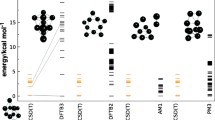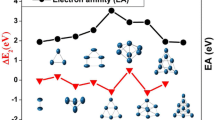Abstract
The high-temperature first-principle molecular dynamics method used to obtain the low energy configurations of clusters [L. L. Wang and D. D. Johnson, PRB 75, 235405 (2007)] is extended to a considerably large temperature range by combination with the quenching technique. Our results show that there are strong correlations between the possibilities for obtaining the ground-state structure and the temperatures. Larger possibilities can be obtained at relatively low temperatures (as corresponds to the pre-melting temperature range). Details of the structural correlation with the temperature are investigated by taking the Pt13 cluster as an example, which suggests a quite efficient method to obtain the lowest-energy geometries of metal clusters.




Similar content being viewed by others
References
Baletto, F., Ferrando, R.: Structural properties of nanoclusters: energetic, thermodynamic, and kinetic effects. Rev. Mod. Phys. 77, 371–423 (2005)
Wales, D.J., Scheraga, H.A.: Global optimization of clusters, crystals, and biomolecules. Science 285, 1368–1372 (1999)
Yoo, S., Zeng, X.C.: Global geometry optimization of silicon clusters described by three empirical potentials. J. Chem. Phys. 119, 1442–1450 (2003)
Wales, D.J., Hodges, M.P.: Global minima of water cluster (H2O)n, n ≤ 21, described by an empirical potential. Chem. Phys. Lett. 286, 65–75 (1998)
Yeo, S.C., Kim, D.H., Shin, K., Lee, H.M.: Phase diagram and structural evolution of Ag-Au bimetallic nanoparticles: molecular dynamics simulations. Phys. Chem. Chem. Phys. 14, 2791–2796 (2012)
Rapallo, A., Rossi, G., Ferrando, R.: Global optimization of bimetallic cluster structures. I. Size-mismatched Ag-Cu, Ag-Ni, and Au-Cu systems. J. Chem. Phys. 122, 194308 (2005)
Shayeghi, A., Götz, D., Davis, J.B.A., Schäfer, R., Johnston, R.L.: Pool-BCGA: a parallelised generation-free genetic algorithm for the ab initio global optimisation of nanoalloy clusters. Phys. Chem. Chem. Phys. 17, 2104–2112 (2015)
Davis, J.B.A., Horswell, S.L., Johnston, R.L.: Global optimization of 8 − 10 atom palladium − iridium nanoalloys at the DFT level. J. Phys. Chem. A 118, 208–214 (2014)
Datta, S., Raychaudhuri, A.K., Dasgupta, T.S.: First principles study of bimetallic Ni13-nAgn nano-clusters (n = 0–13): structural, mixing, electronic, and magnetic properties. J. Chem. Phys. 146, 164301–164308 (2017)
Zhang, M., Fournier, R.: Density-functional-theory study of 13-atom metal clusters M13, M = Ta-Pt. Phys. Rev. A 79, 043203–043210 (2009)
Chou, J.P., Hsing, C.R., Wei, C.M.: Ab initio random structure search for 13-atom cluster of fcc elements. J. Phys. Condens. Mat. 25, 125305–125307 (2013)
Wales, D.J., Doye, J.P.K.: On the thermodynamics of global optimization. J. Phys. Chem. A 101, 5111 (1997)
Wales, D.J., Bogdan, T.V.: Potential energy and free energy landscapes. J. Phys. Chem. B 110, 20765 (2006)
Gehrke, R., Reuter, K.: Assessing the efficiency of first-principles basin-hopping sampling. Phys. Rev. B 79, 085412 (2009)
Rondina, G.G., Silva, J.L.F.D.: Revised basin-hopping Monte Carlo algorithm for structure optimization of clusters and nanoparticles. J. Chem. Inf. Model. 53, 2282–2298 (2013)
Hartke, B.: Global geometry optimization of clusters using genetic algorithms. J. Phys. Chem. 97, 9973–9976 (1993)
Deaven, D.M., Ho, K.M.: Molecular geometry optimization with a genetic algorithm. Phys. Rev. Lett. 75, 288 (1995)
Daven, D., Tit, N., Morris, J., Ho, K.: Structural optimization of Lennard-Jones clusters by a genetic algorithm. Chem. Phys. Lett. 256, 195–200 (1996)
Wang, L.L., Johnson, D.D.: Density functional study of structural trends for late-transition-metal 13-atom clusters. Phys. Rev. B 75, 235405–235410 (2007)
Hu, C.H., Chizallet, C., Toulhoat, H., Raybaud, P.: Structural, energetic, and electronic trends in low-dimensional late-transition-metal systems. Phys. Rev. B 79, 195416 (2009)
Piotrowski, M.J., Piquini, P., Da Silva, J.L.F.: Density functional theory investigation of 3d, 4d, and 5d 13-atom metal clusters. Phys. Rev. B 81, 155446 (2010)
Kresse, G., Furthmüller, J.: Efficiency of ab initio total energy calculations for metals and semiconductors using a plane-wave basis set. Comp. Mater. Sci. 6, 15–50 (1996)
Kresse, G., Furthmüller, J.: Efficient iterative schemes for ab initio total-energy calculations using a plane-wave basis set. Phys. Rev. B 54, 11169–11186 (1996)
Kresse, G., Joubert, D.: From ultrasoft pseudopotentials to the projector augmented-wave method. Phys. Rev. B 59, 1758–1775 (1999)
Kohn, W., And, A.D.B., Parr, R.G.: Density functional theory of electronic structure. J. Phys. Chem. A 31, 12974–12980 (1996)
Görling, A.: Density-functional theory beyond the Hohenberg-Kohn theorem. Phys. Rev. A 59, 3359–3374 (1999)
Nosè, S.: S.: a unified formulation of the constant temperature molecular dynamics methods. J. Chem. Phys. 81, 511–519 (1984)
Piotrowski, M.J., Piquini, P., Zeng, Z.H., Da Silva, J.L.F.: Adsorption of NO on the Rh13, Pd13, Ir13, and Pt13 clusters: a density functional theory investigation. J. Phys. Chem. C 116, 20540–20549 (2012)
Acknowledgements
This work was supported by the National Natural Science Foundation of China (Grant No. 11664038).
Author information
Authors and Affiliations
Corresponding author
Rights and permissions
About this article
Cite this article
Chen, X., Duan, H., Cao, B. et al. The Global Optimization of Pt13 Cluster Using the First-Principle Molecular Dynamics with the Quenching Technique. J Stat Phys 171, 427–433 (2018). https://doi.org/10.1007/s10955-018-2003-3
Received:
Accepted:
Published:
Issue Date:
DOI: https://doi.org/10.1007/s10955-018-2003-3




